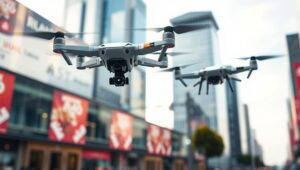The Future of Drones: Smaller, Smarter, and More Versatile (2025)
Drones have rapidly evolved from bulky, expensive gadgets to sophisticated tools with diverse applications. As we approach 2025, the trends point towards drones becoming smaller, smarter, and significantly more versatile. This article explores the key advancements and potential impacts of these developments.
Miniaturization: The Rise of Pocket Drones
One of the most notable trends is the shrinking size of drones. Technological advancements in battery technology, sensor miniaturization, and efficient motor design have paved the way for pocket-sized drones. These compact drones offer enhanced portability and ease of use, making them ideal for recreational use, indoor inspections, and even personal security.
- Enhanced Portability: Easily carried in a backpack or even a pocket.
- Indoor Capabilities: Navigation in confined spaces becomes feasible.
- Lower Cost: Smaller size often translates to lower manufacturing costs, making drones more accessible.
Artificial Intelligence: Smarter Than Ever
The integration of artificial intelligence (AI) is transforming drones into intelligent, autonomous systems. AI algorithms enable drones to perform complex tasks with minimal human intervention. Key AI-driven capabilities include:
- Autonomous Navigation: Drones can navigate complex environments, avoid obstacles, and plan optimal routes without manual control.
- Object Recognition: AI allows drones to identify and track specific objects, people, or animals, enhancing their utility in surveillance and search and rescue operations.
- Data Analysis: Drones can collect and analyze data in real-time, providing actionable insights for various industries.
Versatility: Expanding Applications
Drones are no longer limited to aerial photography and videography. Their versatility is expanding into numerous sectors, including:
- Agriculture: Drones equipped with sensors and cameras can monitor crop health, optimize irrigation, and apply pesticides with precision.
- Logistics: Delivery drones are becoming increasingly common, offering faster and more efficient transportation of goods, especially in urban areas.
- Construction: Drones can inspect infrastructure, monitor progress, and create 3D models of construction sites, improving safety and efficiency.
- Security: Drones provide enhanced surveillance capabilities, patrolling large areas and detecting potential threats.
Challenges and Considerations
Despite the promising future, several challenges need to be addressed to ensure the responsible and effective use of drones:
- Regulation: Clear and consistent regulations are needed to govern drone operations, including airspace management, privacy protection, and safety standards.
- Privacy: Concerns about privacy infringement need to be addressed through the implementation of robust data protection measures.
- Security: Protecting drones from hacking and unauthorized control is crucial to prevent malicious use.
Conclusion
The future of drones is bright, with advancements in miniaturization, AI, and versatility driving their evolution. As drones become smaller, smarter, and more adaptable, their applications will continue to expand across various industries, transforming the way we work, live, and interact with the world. Addressing the associated challenges will be essential to harness the full potential of this transformative technology.




